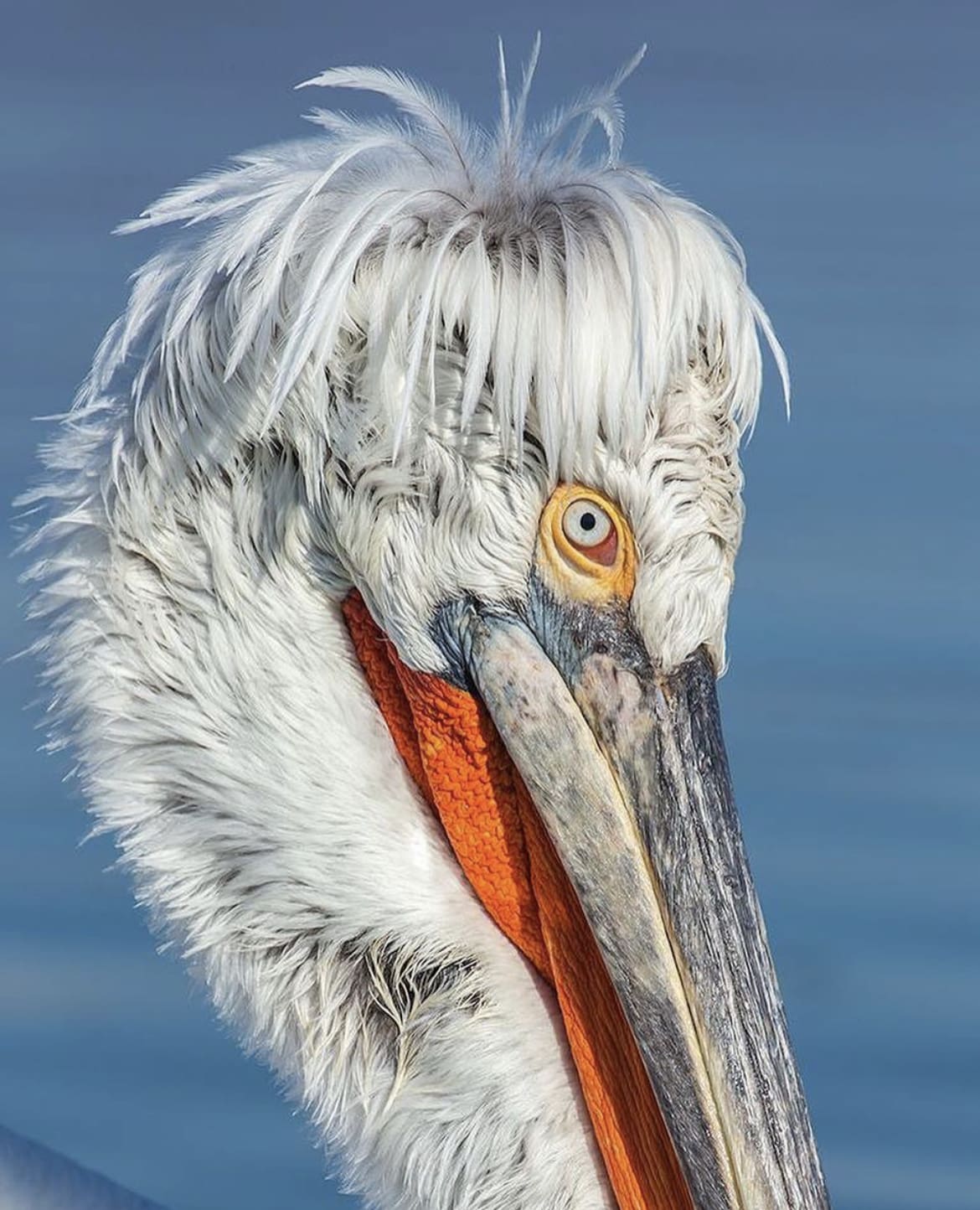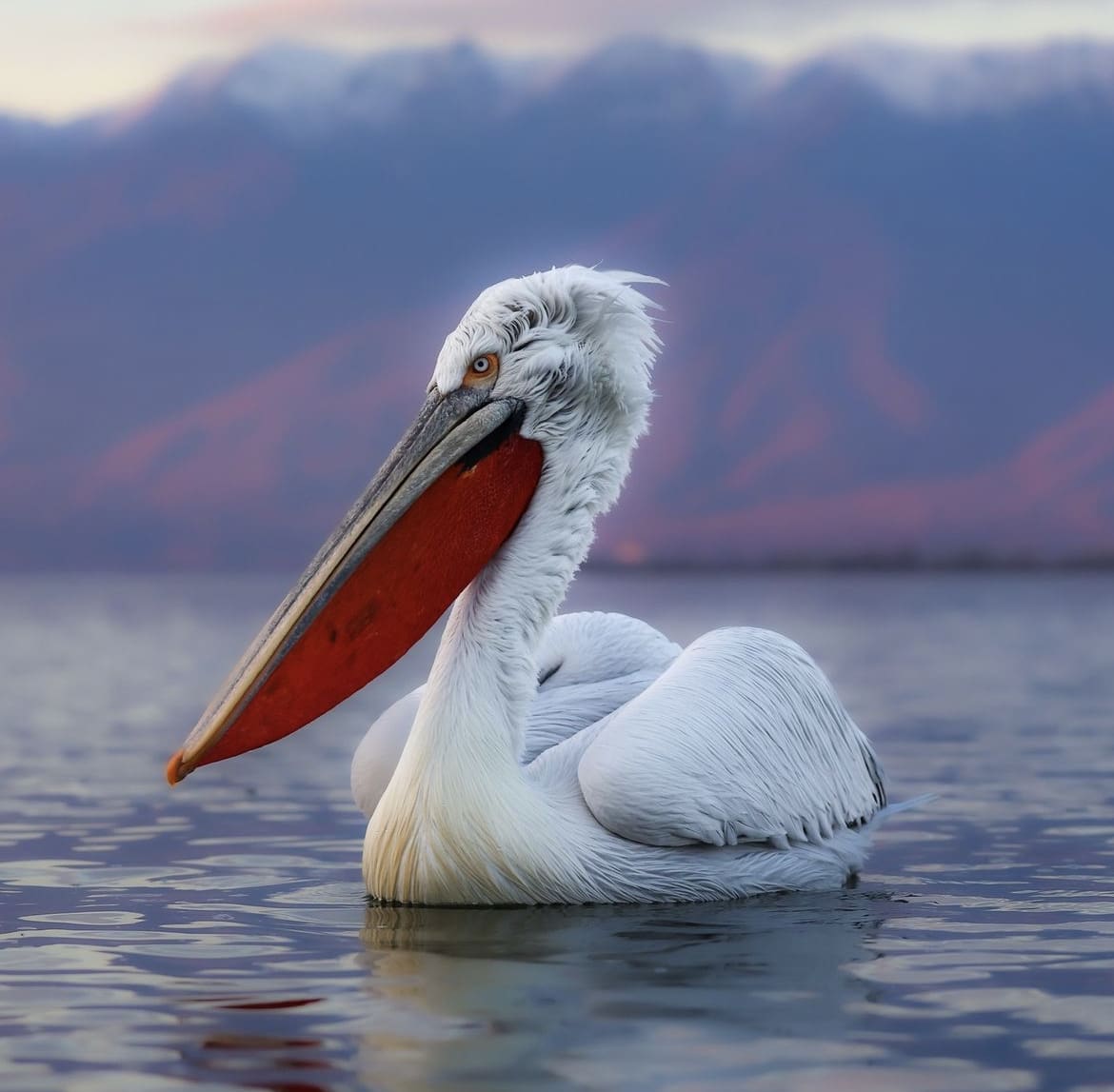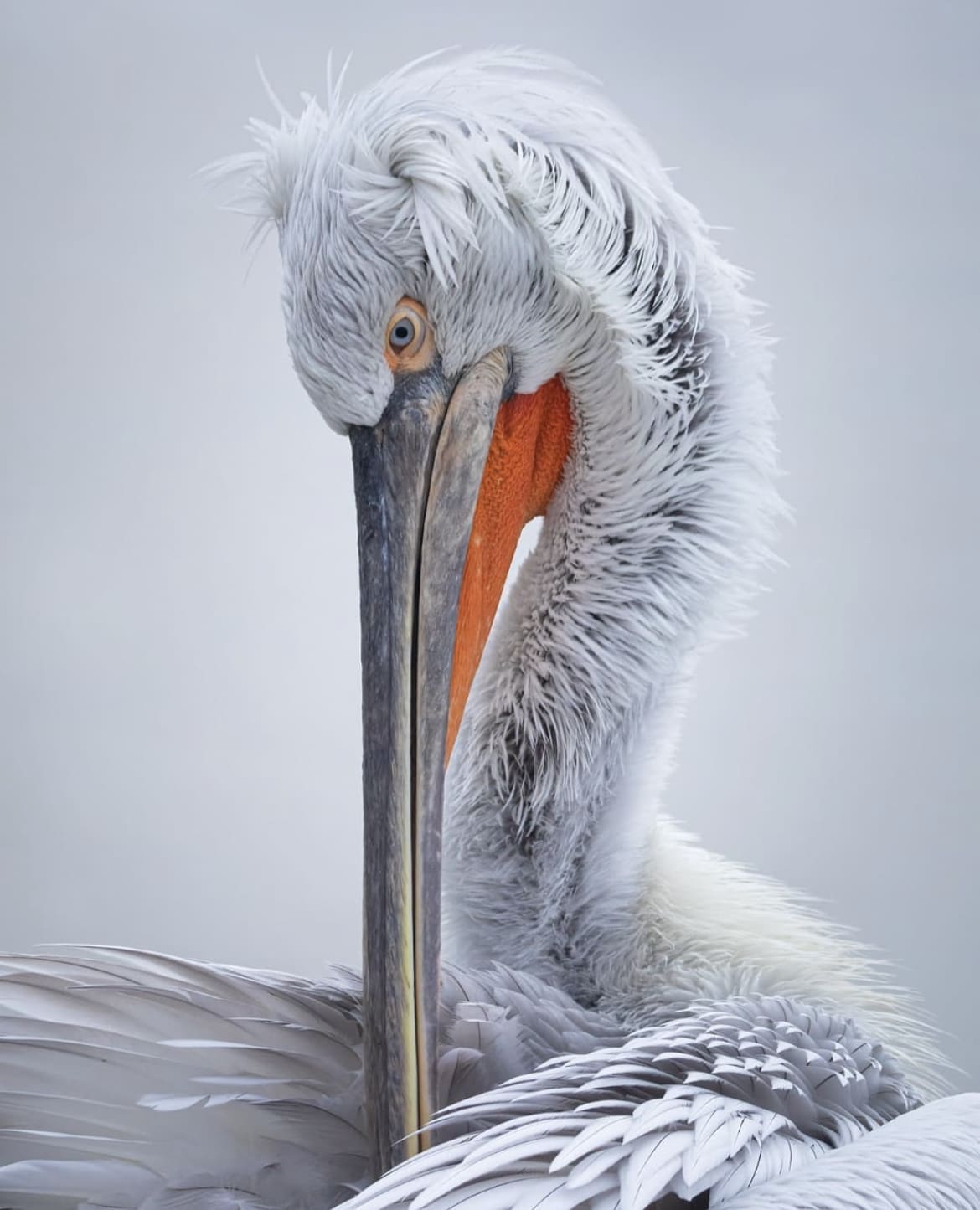[social_warfare]
Ever stumbled upon a bird so grand, it makes you double-take and wonder if you’ve accidentally time-traveled to the era of the dinosaurs? Well, meet the Dalmatian Pelican – nature’s very own feathered giant.
Far from your ordinary park duck, this bird is a spectacle of size, grace, and, let’s be honest, a bit of an oddball charm.
What is the Dalmatian Pelican?
The Dalmatian Pelican (Pelecanus crispus) isn’t your average feathered friend. This bird stands out in the crowd, not just for its massive size but for being one of the heaviest flying bird species around. Part of the pelican family, it’s got all the signature moves: a large bill, a huge throat pouch, and a love for water. But it’s not just any pelican; it’s like the heavyweight champion of the pelican world, boasting some pretty unique features that make it a fascinating subject for birdwatchers and conservationists alike.
Unlike its coastal cousins, the Dalmatian Pelican is more of a freshwater aficionado, favoring the serene lakes, deltas, and wetlands of Europe and Asia. Its lifestyle is a mix of graceful gliding over water surfaces and slightly less graceful, but utterly captivating, feeding frenzies. And if you think its name sounds more like a breed of dog, you’re not alone. However, the name actually comes from its spotted plumage during the breeding season – a fashion statement in the bird world, if you will.

What do Dalmatian Pelicans look like?
Picture this: a bird so large, it looks like it could carry off a small dog (don’t worry, they don’t). The Dalmatian Pelican is a masterclass in avian beauty, with a wingspan that can reach up to 11 feet. That’s right, extend your arms out, and you’re not even close. They’re predominantly a mix of silvery-white and pale gray, with a dash of curly feathers on their nape, giving them a distinguished, if somewhat disheveled, appearance.
Their most iconic feature? That massive bill and gular pouch. Perfect for scooping up fish, this impressive tool can hold more than its fair share of seafood. And when they’re in breeding mode, their bill turns an intense shade of orange, making it clear they’re in the market for love. Add to that their piercing pale eyes, and you’ve got a bird that can go from goofy to majestic in the blink of an eye.
How big are Dalmatian Pelicans?
Okay, so we’ve established they’re big, but just how big are we talking? Adult Dalmatian Pelicans tip the scales at a hefty 22 to 33 pounds. In terms of length, they’re no slouch either, stretching from 5 to 6 feet from beak to tail. That’s taller than some humans when you measure from tip to tail!
But it’s not just their body size that’s impressive. Those wings are built for long-haul flights, allowing them to migrate and cover vast distances without breaking a sweat. It’s like having your own private jet wings, except, you know, they’re attached to your body. This combination of size, strength, and stamina makes the Dalmatian Pelican a true marvel of the natural world, showcasing the incredible diversity and adaptability of bird species.
Dalmatian Pelican Wings
When it comes to the Dalmatian Pelican, their wings are nothing short of an engineering marvel. With a wingspan that can stretch up to 11 feet, these birds are the epitome of airborne elegance. Imagine a bird that, with just a few powerful strokes, can lift off and glide across the sky with the grace of a ballet dancer and the precision of a fighter jet. That’s your Dalmatian Pelican for you.
Their wings are not just for show; they’re crucial for migration and foraging. These birds are known to travel long distances between their breeding and wintering grounds, relying on their robust wings to carry them over hundreds, sometimes thousands, of miles. Whether they’re catching a thermal to soar effortlessly or flapping vigorously to gain altitude, their wings are their ticket to a nomadic lifestyle that takes them across continents.
@seanweekly
Beak
Moving on from their impressive wings to another hallmark feature: their beak. If the Dalmatian Pelican’s wings are their passport to travel, their beak is the ultimate survival tool. This isn’t just any beak; we’re talking about a long, hefty, and incredibly versatile appendage that can measure over a foot in length. The beak, complete with a hook at the end for gripping slippery fish, is a testament to the pelican’s fishing prowess.
The real magic happens with the gular pouch – a stretchy, expandable bag of skin that hangs from their lower beak. This isn’t just for storing fish; it’s a highly efficient fishing net, allowing the pelican to scoop up water and fish in a single dive. After closing their mouth, they’ll drain the water, leaving only the fish behind for a tasty meal. This unique feeding technique showcases the Dalmatian Pelican’s adaptation to its aquatic lifestyle, making it a top-tier fisherman of the bird world.
Coloration
The Dalmatian Pelican’s color palette is as understated as it is beautiful. Dominated by shades of grey, white, and silver, their plumage might not scream ‘tropical parrot’, but it has a serene elegance that is captivating. During the non-breeding season, their feathers take on a more subdued tone, blending seamlessly with the misty mornings of their wetland habitats.
However, it’s during the breeding season that these birds decide to dress to impress. Their plumage brightens, and they sport a nifty crest of feathers on the back of their heads, adding a bit of flair to their already impressive silhouette. The most dramatic change occurs in their bill and pouch, which turn a vibrant shade of orange, signaling their readiness to mingle and attract a mate. This seasonal transformation adds an exciting chapter to the life story of these magnificent birds, showcasing the dynamic nature of wildlife and the ever-changing canvas of the natural world.

What do Dalmatian Pelicans eat?
The Dalmatian Pelican’s menu is pretty straightforward: fish, and lots of it. But we’re not talking about a light snack here. These birds can eat up to 4 pounds of fish a day! Their preferred cuisine? Generally, it’s whatever’s available in their freshwater homes – from carp to eels, they’re not picky eaters. Thanks to their specialized beak and pouch, they’ve turned fishing into an art form.
Sometimes, they’ll even team up, forming a semi-circle to corral fish into shallow waters for an easier catch. It’s like a synchronized swimming routine, but with a more culinary end goal.
Social Structure
Dalmatian Pelicans are pretty sociable creatures, especially when it comes to feeding and breeding. Outside the breeding season, they gather in large flocks, often mixing with other pelican species, to fish and migrate. These gatherings can be quite the spectacle, with dozens of pelicans working in unison to herd fish.
But when the breeding season rolls around, they prefer a bit more privacy. They nest in colonies, yes, but with a respectable distance between nests. Think of it as their version of suburban living – close enough to the neighbors for a quick visit, but with plenty of space for the kids to play. This social structure ensures both a tight-knit community for raising their young and enough elbow room to avoid squabbles over territory.

How do Dalmatian Pelicans reproduce?
When it comes to romance, Dalmatian Pelicans have a rather sweet side. Courtship involves a lot of head-bobbing, bill-clattering, and an impressive display of their vibrant pouches. Once a pair bonds, they’re in it for the long haul, working together to build a nest. These are usually constructed from reeds, sticks, and feathers, situated on isolated islands or dense reed beds – essentially, anywhere safe from predators and nosy neighbors.
The female lays a clutch of usually 2 to 4 eggs, and both parents take turns incubating them for about a month. Once the chicks hatch, the parenting duties kick into high gear. Dalmatian Pelican parents are attentive, feeding their offspring a regurgitated mix of fish – baby food, pelican style. It’s a full-time job for both mom and dad, ensuring their fluffy grey chicks grow up healthy, strong, and ready to take on the world.
How long do Dalmatian Pelicans live?
Dalmatian Pelicans are among the avian world’s more long-lived members, with a lifespan that can stretch up to 30 years in the wild. In captivity, with threats like predators and diseases managed, they can live even longer. This impressive longevity allows them to form lasting bonds, both with their mates and within their flocks.
It also means they can return to the same breeding sites year after year, creating a deep connection with their chosen nesting grounds. However, reaching such a ripe old age in the wild is no small feat, requiring luck, skill, and a little bit of pelican wisdom to navigate the challenges of nature.

Are Dalmatian Pelicans aggressive?
Despite their formidable size and somewhat prehistoric appearance, Dalmatian Pelicans are not particularly aggressive by nature. Like any wild animal, they can display defensive behavior if they feel threatened, especially during the breeding season when they’re protecting their nests. However, these pelicans are more likely to flee than fight when faced with human intrusion.
That said, their social nature does mean that they have to navigate the dynamics of flock life, which can involve some squabbling, particularly over food. Yet, these interactions rarely escalate into serious conflicts, as the birds have developed a complex system of communication and social cues to maintain harmony within the group.
Are Dalmatian Pelicans territorial?
During the breeding season, Dalmatian Pelicans do become more territorial, as they seek to protect their nests and ensure the best possible start for their offspring. Each pair requires a certain amount of space around their nest to feel secure, leading to what could be described as a form of avian “neighborhood watch.” They vigilantly guard their immediate nesting area from potential threats, including other pelicans that wander too close.
Outside of breeding season, however, Dalmatian Pelicans are much less concerned with territory. They gather in large, sometimes mixed-species flocks to feed and migrate, demonstrating a high degree of social tolerance. This duality in their behavior highlights the adaptability of Dalmatian Pelicans, able to shift from solitary nesters to communal travelers as the seasons change.

How fast are Dalmatian Pelicans?
When it comes to speed, Dalmatian Pelicans might not be the first birds you think of as speedsters. Yet, these birds are surprisingly agile in the air, capable of reaching speeds up to 35 miles per hour (56 km/h) during flight. This speed, combined with their stamina and the ability to use thermal currents to their advantage, makes them proficient travelers across vast distances. Whether it’s their seasonal migrations or daily movements in search of food, Dalmatian Pelicans have mastered the art of efficient flight, showcasing that size is not a hindrance to speed and agility in the avian world.
Where do Dalmatian Pelicans live?
Dalmatian Pelicans are true cosmopolitans of the wetland world. They favor a range of freshwater habitats, from large, shallow lakes to deltas, rivers, and wetlands. Their distribution spans from southeastern Europe through to Russia, China, and India, with wintering populations heading to ice-free waters in the Mediterranean, the Caspian Sea, and parts of southern Asia.
These habitats provide not just the fish they need to sustain their considerable size but also isolated areas suitable for nesting. Dalmatian Pelicans are particularly fond of locations that offer a mix of open water for feeding and dense vegetation for breeding, showcasing their adaptability to different environmental conditions. Yet, their dependence on these specific habitats makes them vulnerable to changes in their ecosystems, a challenge that has significant implications for their conservation.

How many Dalmatian Pelicans are there in the wild?
Estimating the exact number of Dalmatian Pelicans in the wild is challenging due to their wide distribution and the inaccessibility of some of their breeding sites. However, it is believed that the global population is between 10,000 to 20,000 individuals. This number reflects a cautious optimism, as conservation efforts in some regions have helped stabilize and even increase local populations.
Despite these efforts, Dalmatian Pelicans remain one of the less common pelican species, classified as Near Threatened by the IUCN Red List. Their numbers are a stark reminder of the delicate balance that these birds maintain within their ecosystems and the ongoing need for protection and habitat preservation to ensure their survival.
Are Dalmatian Pelicans endangered?
The Dalmatian Pelican is currently listed as Near Threatened on the IUCN Red List. While this status indicates that they are at risk of becoming endangered, it also highlights the success of conservation efforts that have somewhat stabilized their populations. The primary concern for the Dalmatian Pelican is not its current numbers but the ongoing threats that could lead to a rapid decline if not adequately addressed.
Conservationists are working tirelessly to ensure that this species doesn’t slip into a more precarious situation, advocating for habitat protection, anti-poaching measures, and public awareness to support these iconic birds.

Threats to Dalmatian Pelicans in the wild
The biggest threats facing Dalmatian Pelicans stem from human activity and environmental changes. Habitat loss due to agriculture, water pollution, and the construction of dams and water management systems have significantly reduced their breeding and feeding grounds. Climate change also poses a long-term threat, altering the water levels of their habitats and impacting fish populations, their primary food source.
Furthermore, unintentional entanglement in fishing nets and persecution in certain areas continue to pose significant risks to their survival. Conservation measures are in place in many regions, focusing on protecting key habitats, regulating fishing practices, and raising public awareness about the importance of these birds to the ecosystem’s health.
Where to see Dalmatian Pelicans in the wild
For those inspired to see these gentle giants in their natural setting, there are several key locations across Europe and Asia where Dalmatian Pelicans can be observed, especially during the breeding season. The Prespa Lakes in Greece and North Macedonia, the Danube Delta in Romania, and parts of the Caspian Sea are renowned for their Dalmatian Pelican populations. In Asia, locations like Lake Poyang in China offer a glimpse into the lives of these birds.
When planning a visit to these areas, it’s essential to go with a responsible ecotourism mindset, ensuring that your presence doesn’t disturb the pelicans or their habitat. Many reserves and parks offer guided tours, providing not only an opportunity to witness these birds up close but also to learn about their behaviors, threats, and the conservation efforts in place to protect them.

Tips for spotting Dalmatian Pelicans in the wild
Spotting a Dalmatian Pelican can be a thrilling experience, but it requires patience, respect for nature, and a bit of know-how. Here are some tips to increase your chances of a memorable encounter:
- Time Your Visit: Early morning or late afternoon are the best times to see Dalmatian Pelicans, as they are most active during these periods.
- Choose the Right Season: The breeding season (late winter to spring) is an excellent time to see them in their breeding plumage and engaging in social behaviors.
- Use Binoculars or a Telephoto Lens: Keeping a respectful distance is crucial. Binoculars or a telephoto lens can help you get a closer look without disturbing them.
- Look for Large Bodies of Water: Dalmatian Pelicans prefer wetlands, lakes, and estuaries. Researching known habitats or conservation areas can lead you to the right spot.
- Join a Guided Tour: Consider joining a wildlife tour led by experts. It’s a great way to learn more about pelicans while ensuring that your visit has a minimal impact on their natural environment.
Facts about The Dalmatian Pelican
Here are some intriguing facts about the Dalmatian Pelican that highlight their unique place in the natural world:
- Impressive Wingspan: Their wingspan is among the largest of any living bird, rivaling that of the great albatross.
- Ancient Species: Fossil records show that pelicans have been around for over 30 million years, with the Dalmatian Pelican being one of the oldest species.
- Seasonal Changes: Their bill and pouch change color during the breeding season, turning a vibrant orange to attract mates.
- Cooperative Hunters: Dalmatian Pelicans often hunt in groups, coordinating their movements to corral fish into shallow waters.
- Long-Distance Migrants: Some populations migrate long distances between breeding and wintering grounds, showcasing remarkable endurance.

Myths about The Dalmatian Pelican
Let’s clear up some common myths about Dalmatian Pelicans to better understand these birds:
- Myth: Pelicans store food in their pouch. Fact: The pouch is used to catch and drain water from the fish before swallowing, not for storage.
- Myth: Dalmatian Pelicans are aggressive towards humans. Fact: They are generally shy and avoid human contact. Aggressive behavior is rare and usually defensive.
- Myth: They can carry large animals or children in their pouch. Fact: While their pouch is large and flexible, it’s designed for fishing and cannot support heavy loads.
